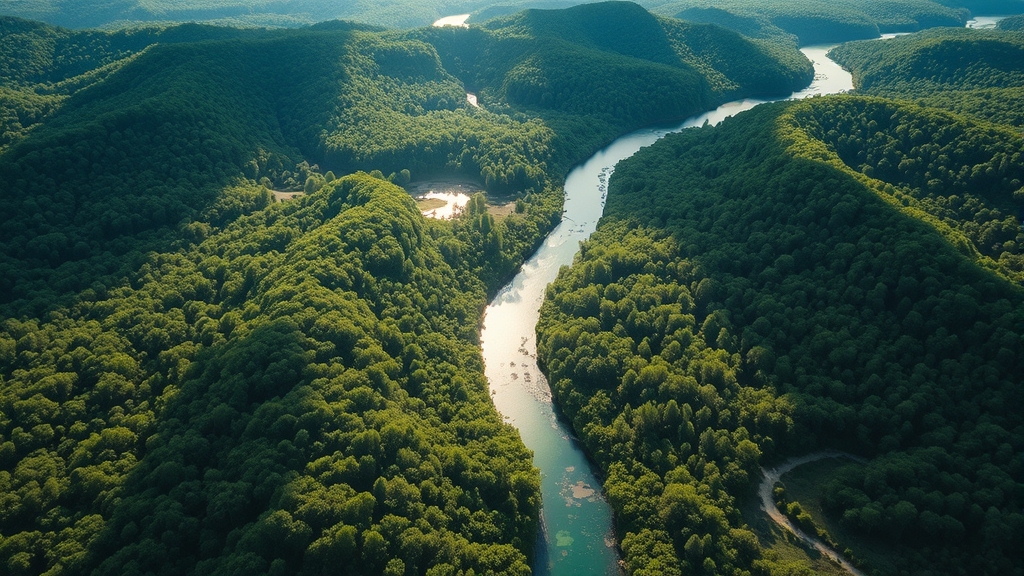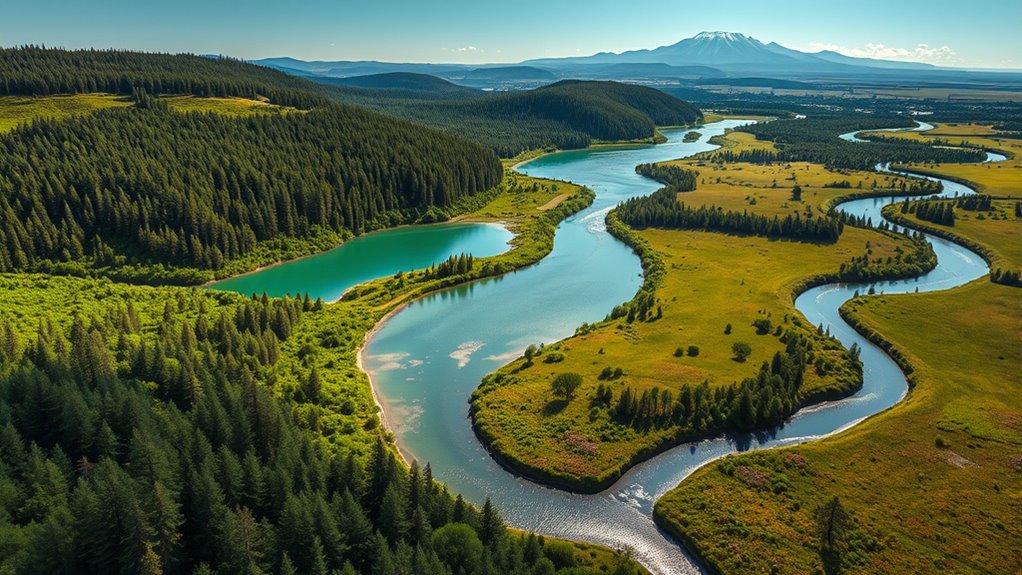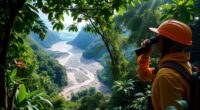The 30×30 Conservation Pledge asks you to help protect 30% of Earth’s land and water by 2030, aiming to preserve biodiversity, fight climate change, and support ecological health. Focusing on biodiversity hotspots and restoring habitats, this effort encourages connectivity among protected areas and strong policies. Your involvement in conservation initiatives, volunteering, or raising awareness can make a real difference. To explore how you can contribute and why this goal matters, keep exploring further.
Key Takeaways
- The 30×30 Conservation Pledge aims to protect 30% of Earth’s land and water by 2030 to conserve biodiversity.
- It focuses on safeguarding critical ecosystems known as biodiversity hotspots for ecological health.
- The initiative promotes habitat restoration and connectivity to support species survival and ecosystem resilience.
- Policy support and collective actions, including community involvement and protected area expansion, are essential for success.
- The pledge represents a global effort to ensure long-term environmental sustainability for future generations.

Have you heard about the 30×30 Conservation Pledge? It’s a bold global effort to protect 30% of Earth’s land and water by 2030. The goal is ambitious but essential, considering how much our planet’s ecosystems are under threat. When you think about protecting biodiversity, you might picture pristine forests or vibrant coral reefs. But the focus is broader, targeting areas that are indispensable for the health of our planet. These regions, known as biodiversity hotspots, are teeming with life but face intense pressure from human activities. By prioritizing these hotspots, your efforts can have a significant impact on safeguarding rare species and maintaining ecological balance.
To meet this pledge, habitat restoration plays a key role. Restoring damaged ecosystems isn’t just about planting trees; it involves repairing the delicate web of life that sustains countless species. When you support habitat restoration, you help revive degraded landscapes, turning barren land back into thriving habitats. This process not only benefits local wildlife but also improves ecosystem services like clean water, air quality, and climate regulation. Restoring habitats also acts as a buffer against climate change, helping species adapt to changing conditions and reducing the risk of extinction. Additionally, conservation technology is increasingly used to monitor and manage protected areas more effectively, making restoration efforts more targeted and successful. Utilizing advanced monitoring systems enhances our ability to track ecological health and ensure the longevity of restored habitats. Incorporating such technology can improve biodiversity monitoring and support adaptive management strategies.
Supporting habitat restoration revives ecosystems, benefits wildlife, and helps combat climate change.
As you get involved, you’ll see that protecting 30% of the planet isn’t just about setting aside land and water. It’s about creating interconnected protected areas that allow species to migrate, reproduce, and survive. This connectivity is essential for maintaining genetic diversity and resilience. When you advocate for policies that expand protected areas or support local communities in conservation efforts, you help guarantee these landscapes remain vibrant and sustainable for future generations. Supporting biodiversity preservation initiatives can further amplify these efforts by ensuring that diverse ecosystems are maintained and protected.
The 30×30 pledge also emphasizes the importance of collaboration. Governments, organizations, and individuals like you all have a role to play. Supporting initiatives that focus on conserving biodiversity hotspots and investing in habitat restoration projects can accelerate progress. Whether it’s volunteering, donating, or spreading awareness, your actions contribute to a global movement that aims to heal our planet’s wounds. The future of Earth depends on collective effort, and the 30×30 target provides a clear, measurable goal.
In the end, protecting 30% of Earth by 2030 isn’t just an environmental target; it’s a commitment to preserve the natural world for yourself, your children, and all life. Every step you take toward supporting biodiversity hotspots and habitat restoration helps turn this vision into reality. By acting now, you become part of a movement that can truly make a difference in safeguarding our planet’s rich and diverse ecosystems. Recognizing the importance of ecosystem health underscores the need for ongoing conservation initiatives to maintain biodiversity over the long term.
Frequently Asked Questions
How Will Indigenous Communities Be Involved in 30X30 Efforts?
You’ll see Indigenous communities actively involved in 30×30 efforts through community engagement and respecting Indigenous sovereignty. Their traditional knowledge helps protect ecosystems, and their leadership ensures conservation is culturally appropriate. By collaborating with Indigenous peoples, you support their rights and foster meaningful partnership, making conservation more effective. This approach recognizes their essential role in safeguarding biodiversity, empowering communities, and creating sustainable solutions for the planet’s future.
What Are the Economic Benefits of Achieving 30X30?
Imagine boosting your local economy through conservation efforts. Achieving 30×30 brings eco tourism benefits, attracting visitors enthusiastic to explore protected lands. This influx creates new job opportunities, from guiding tours to conservation work, fostering sustainable growth. As ecosystems flourish, so do businesses and communities, ensuring long-term economic stability. You’ll see how protecting nature directly fuels economic vitality, making conservation a smart investment for everyone’s future.
How Does Climate Change Impact the 30X30 Conservation Goals?
Climate change challenges your 30×30 goals by threatening ecosystems and reducing climate resilience. As temperatures rise, habitats degrade, and species struggle to adapt. This impacts carbon sequestration efforts, making it harder to absorb greenhouse gases. To stay on track, you need to prioritize protecting and restoring natural areas, enhancing climate resilience, and boosting carbon sequestration. Addressing climate change is essential to guarantee your conservation goals succeed and benefit future generations.
What Are the Main Challenges in Reaching 30% Protection Worldwide?
Did you know that over 80% of the Earth’s land remains unprotected? You face challenges like biodiversity loss, which threatens ecosystems, and funding shortages that hinder conservation efforts. These obstacles make it tough to reach your goal of protecting 30% of the planet. To succeed, you need increased investment, stronger policies, and global cooperation to overcome these barriers and preserve essential habitats for future generations.
How Can Individuals Contribute to the 30X30 Pledge?
You can contribute to the 30×30 pledge through personal action and community involvement. Start by supporting conservation efforts locally, like volunteering with environmental groups or advocating for protected areas. Spread awareness about the importance of protecting nature, and make eco-friendly choices in your daily life. Your active participation can inspire others, creating a collective impact that helps reach the global goal of conserving 30% of Earth by 2030.
Conclusion
By joining the 30×30 pledge, you’re stepping into the footsteps of explorers like Darwin, committed to safeguarding our planet’s wonders. Just as he uncovered nature’s secrets, you help preserve its beauty for future generations. Remember, every effort counts—your actions today echo like ripples across the oceans, ensuring Earth remains a vibrant, thriving world. Together, we can write a new chapter—one where nature’s legacy endures, all starting with your commitment.









